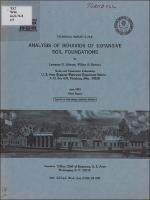Please use this identifier to cite or link to this item:
https://hdl.handle.net/11681/20569| Title: | Analysis of behavior of expansive soil foundations |
| Authors: | Soils and Pavements Laboratory (U.S.) Johnson, Lawrence D. Stroman, William R. |
| Keywords: | Expansive soils Foundations Soil swelling Soil mechanics |
| Publisher: | Soils and Pavements Laboratory (U.S.) Engineer Research and Development Center (U.S.) |
| Description: | Technical Report Abstract: The differential heave of foundation soil from moisture imbibition often causes major damage to overlying structures. Many methods have been proposed for estimating expansive soil heave, but there are no proven guidelines for evaluating the behavior of foundations on swelling soils. Foundations built on expansive soils are often designed without considering the swelling properties of the soil, resulting in unsightly cracking or structural damage to the completed building. A practical method for evaluating the behavior of foundations on undisturbed expansive soil involves: (A.) A site study. (B.) Laboratory tests on typical samples. (C.) Prediction of the total and differential heave of the foundation soil beneath various types of foundations. (D.) Choice of a suitable and economical foundation design. The site study will help define the relative vulnerability of the foundation soils to heave, indicate the soil strata that have the most likely potential for swell, and provide samples for laboratory tests. The type of foundation is usually controlled by the structural and architectural requirements and site and subsurface soil characteristics. Reliable predictions of in situ heave and rate of heave are extremely difficult to obtain. Many factors are involved, such as soil composition, stratification, soil structure, fissures, maximum past pressure, degree of initial desiccation, climatic conditions, availability of water to the soil, lateral forces, surcharge pressure, time, and temperature. Reasonable estimates of heave can be derived from swell tests and appropriate deductions. The constant volume swell and modified swell overburden tests done on undisturbed soil specimens were found practical for approximating the effects of the aforementioned factors on foundations. The computer code developed to expedite heave predictions contains this option: the final or equilibrium moisture condition may be either (1.) a state of full saturation (an active zone with no negative pore-water pressures) or (2.) an equilibrium based on a negative hydrostatic head increasing in magnitude with decreasing depth in the active zone. The active zone is defined as the depth of soil below ground surface subject to changing moisture conditions. Differential heave may be simply estimated, given the difference in heave predicted at different locations of the foundation. Predicting the amount of heave is necessary for designing a heave-resistant structure. Soil-related design features include soil stabilization techniques and drainage. Structurally related design features include type of foundation (such as a reinforced slab or grade beam on piers), joints, diameter and depth of piers, and amount of reinforcing steel in the concrete. |
| Rights: | Approved for public release; distribution is unlimited. |
| URI: | http://hdl.handle.net/11681/20569 |
| Appears in Collections: | Technical Report |
Files in This Item:
| File | Description | Size | Format | |
|---|---|---|---|---|
| TR-S-76-8.pdf | 8.21 MB | Adobe PDF |  View/Open |